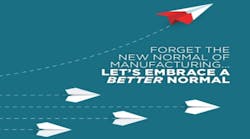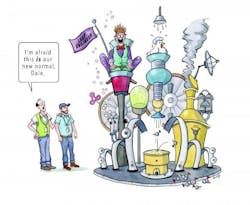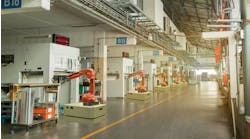Forget the new normal of manufacturing...let's embrace a better normal
By Chris McNamara, Smart Industry editor in chief
The phrase often has a negative connotation: the new normal. It’s how you might describe life after a debilitating accident or the loss of a loved one. Things are different. Not necessarily better. But this is the new normal… get used to it.
We’ve been hearing that phrase a lot in the manufacturing space as we emerge—finally—from the coronavirus pandemic. Factories are reopening. Supply chains are stabilizing. Workers are returning to work. Customers are looking for products and services.
And within that manufacturing space, in recent months at least, the phrase "the new normal" is being uttered with a tinge of optimism. The new normal is a response to a pandemic, of course, but it also heralds a better way of operating—a better normal.
Here we consider some of the pandemic-prompted problems and the emerging “new normal” outcomes that might more aptly be described as a “better normal.”
PANDEMIC-PROMPTED PROBLEM: SUPPLY CHAIN DISRUPTION
Many of us were crippled during the pandemic by supply chains that stopped supplying. And suppliers were unable to deliver their goods to eager customers. The more complicated and international supply chains were, the more likely both camps were to suffer.
“The COVID-19 pandemic created a major shock to the system,” explains Caroline Pan, Bright Machines CMO. “It showed us the fragility of global manufacturing and highlighted the growing importance of having a more distributed factory network with localized sourcing and production.”
A BETTER NORMAL: SMARTER SUPPLY CHAINS
The upside here is that business owners are now thinking much more critically about issues they haven’t dealt with in decades—how to reshore manufacturing, how to increase domestic production, how to speed up innovation, how to hire and train the right manufacturing talent close to home.
taking is this—circumventing the supply chain altogether. Decentralized manufacturing employing 3D-printing capabilities has enabled greater flexibility in producing certain parts; if the gear or the heart valve or the facemask you need is stuck on a barge somewhere, you can just print your own version. “Distributed manufacturing has made it possible to instantly share designs to locations around the world, so products can be made closer to the customer, putting the focus back on to product design and innovation, rather than supply chain,” explains Paul Sagar, PTC's vice president of product management. No supply chain, no problem.
PANDEMIC-PROMPTED PROBLEM: SICK WORKERS ENDANGERING PEERS WITHIN FACILITIES
While we were all trying to figure out what, exactly, was "safe" human interaction at the start of the pandemicwithin factories and grocery stores and schools—many facilities entirely shut down. Thankfully, factories and plants have begun reopening with new protocols and tools in place to instill confidence in workforces.
But even as we emerge from this global health crisis, we are left with worry about the future. When will the next pandemic strike and could it make coronavirus look like child’s play?
A BETTER NORMAL: SAFER WORKSPACES AND REMOTE-WORK ADVANCEMENTS
We’ve seen countless ingenious tools and practices spring up to keep workers safe. Booze distilleries pivoted to produce hand sanitizer. Manufacturing lines were changed to churn out personal protective equipment. Rapid temperature scanners were installed at factory entrances. We distanced—social and professionally—and we willingly wore masks.
“The pandemic forced us to ask some fundamental questions. How do people check into a building? How do we know how many occupants can be in a building?” says Corey Glickman, global head of sustainability and design consulting services with Infosys. “Then it got really scientific, to the level where part of our COVID solution was to work with sensors to understand micron levels and density of air molecules.”
The pandemic forced us to consider new processesqueuing for elevator systems and relying on digital signage. These lessons will remain post-pandemic.
Ingenious adjustments were commonplace. Teams at Emerson facilities helped existing nonwoven-product manufacturers to refurbish aging PPE-manufacturing equipment to quickly bring new capacity online. Their personnel collaborated with new-to-the-market players to create innovative PPE-production automation solutions.
Or consider Honeywell Sine—a mobile solution to enable the safe return to industrial facilities by managing occupancy levels and tracking the flow of workers throughout the facility. “This type of communication is critical in providing employees with updates about their workplaces, especially when implementing hybrid-work models,” says Usman Shuja, vice president and general manager of Connected Buildings for Honeywell.
PANDEMIC-PROMPTED PROBLEM: INSUFFICIENT AUTOMATION & REMOTE CAPABILITIES
This global crisis has demanded that we fast-track automation across industries to not just mitigate vulnerabilities but to wholly optimize our systems.
Arjun Devadas, senior vice president of professional services & operations with Vuram, believes that the pandemic is piquing interest in the extreme version of automation—known as hyperautomation—integrating a multitude of complementary technologies like artificial intelligence, business-process management, process mining and machine learning. “Hyperautomation is a mindset and a continual journey for an organization. For those that are looking to scale existing hyperautomation efforts, now is the time.”
The same goes for remote approaches. You might be reading this article while working from home. Those closed factories highlighted gaps in our abilities to monitor industrial assets from outside facilities and, concurrently, for plant personnel to perform their duties remotely. The lights-out plant concept has long been intriguing, but when that approach was required, many of us learned we weren’t ready to flip the switch.
A BETTER NORMAL: CONTROLLING FACILITIES FROM AFAR
Tools that were considered “nice to have” are now considered “must haves.” Think control-system software that delivers true, comprehensive visibility on asset health directly to the screen/eyes of engineers, wherever they are. Or, in emergency situations, managers can be awakened via their cellular phone with an alert to make a fix quick. “Bill! This is the factory calling…we’ve got a problem!”
Or consider smart cameras empowered by artificial intelligence, which can accurately monitor worker behavior to enforce standard operating procedures and alert personnel and machines when humans get too close to dangerous assets. What was formerly the domain of plant-floor managers can now be automated and analyzed remotely.
“The new normal of remote home working will be permanent for many employees and organizations,” surmises Morten Boel Sigurdsson, Omada founder and president of North America. “Getting a better handle on the finegrained policies that need to be implemented for a longterm remote setup can be the foundation for introducing automation of identity management and provisioning.”
PANDEMIC-PROMPTED PROBLEM: AN EXPLOSION OF WASTE
Lastly, our reliance on personal protective equipment and disposable, well, everything has spiked the production and disposal of plastics.
“Recyclers worldwide have seen their businesses shrink by more than 20% in Europe by 50% in parts of Asia and as much as 60% for some firms in the US,” states Dr. Richard Ahlfeld CEO of Monolith, who blames the change on an unprecedented demand for single-use plastics, a safer, more hygienic option for myriad items including hospital gowns and food containers—that spiked in demand throughout the past year and a half.
This serious problem pre-pandemic has snowballed since.
A BETTER NORMAL: EMPLOYING ARTIFICIAL INTELLIGENCE TO REDUCE PLASTIC WASTE
AI holds promise for the packaging industry in reducing the volume of plastic used, eliminating unnecessary use and guiding our efforts to reuse this material.
Take Amazon, which has developed an AI model that learns from customer complaints about damaged products and specifies better forms of packaging.
Ahlfeld notes another (often unseen) way that AI can reduce waste: smarter recycling systems. He points to AMP Robotics, which has created an AI-powered robot called Cortex that can analyze hard-to-sort recyclables.
Is our plastic situation ideal? Hardly. But we’re learning lessons on this and every other front courtesy of the pandemic. Infosys’ Glickman believes this crisis has highlighted one of the key benefits of approaches enabled by the Industrial Internet of Things: the ability to futureproof.
While the need of the hour is addressing COVID, many of the solutions that continue to spring up can be repurposed for other problems. Once we fully overcome the pandemic, we can, for example, start transferring new sensors to new tasks, including making healthier, more efficient industrial facilities that are more welcoming to workforces, wherever they may be working.
“The pandemic effectively accelerated innovation,” Glickman says. “Shrinking years of progress into a matter of months.”
We are emerging from this crisis working wiser, working more safely and—if you will allow me to play psychologist—with a greater confidence in our ability to adapt, to pivot and respond to a Herculean challenge with smart solutions empowered by a marriage of cutting-edge technology and old-fashioned human ingenuity.




